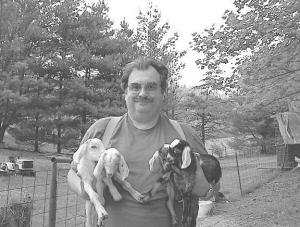2004 - Volume #28, Issue #4, Page #09
[ Sample Stories From This Issue | List of All Stories In This Issue | Print this story
| Read this issue]
Mini-Dairy Goats Catching On Fast
 |
They're ideal for people with smaller farms who want a smaller dairy animal that takes less space and feed, but still gives back milk for the family, according to Susan and Vencil Selvage of Whispering Pines Farm at Ferrum, Va., who raise and sell Mini-Nubians.
The small goats are a cross between Nigerian Dwarfs and full-size Nubians, both of which are dairy goat breeds.
Mini-Nubians are one of six miniature dairy goat breeds that are currently being developed by interested breeders like the Selvages. All are encompassed by the Miniature Dairy Goat Association, based in Corvallis, Ore.
Registrar Jeanne Carson says the size of all these various existing dairy breeds is being reduced by crossing with the Nigerian Dwarf, and each one is being transformed into a new and miniature version of the breed.
"The first generation is called a 50/50. When you breed two 50/50's, you get a second generation. The first and second generations are called experimentals because the breed characteristics you get aren't consistent yet. You keep selecting from each generation for the breed traits you want," according to Carson. "You can apply for purebred registration on third generation animals that have produced at least one offspring. Both they and their offspring must meet the association's breed criteria."
She says the registry has been in existence for eight years. There are only 15 registered Mini-Nubians in the purebred herd book (registry) so far, but there are close to 2,500 animals in the experimental registry (mostly Mini-Nubians and Mini-Lamancha), so a lot more purebred registrations are expected this year. Registry personnel decide if stock is eligible for registration by viewing pictures and documentation sent in by the breeders.
There are many reasons why miniature dairy goats are catching on, according to Carson. The traditional purebred dairy goat breeds have been pushing for greater stature in the show ring, which has resulted in all the dairy goat breeds getting larger in recent years. Smaller goats are easier for children and seniors to handle and are in demand for the pet market.
"Feed costs are rising and a smaller goat can often produce two thirds as much milk as a standard dairy goat while often consuming only half the amount of feed," she says.
Contact: FARM SHOW Followup, Whispering Pines Farm, Vencil and Susan Selvage, 3080 Turners Creek Rd., Ferrum, Va. 24088 (ph 540 365-1696; email: sselvage@cablenet-va.com; sselvage22@yahoo.com; website: www.geocities.com/dixiemininubians) or Jeanne Carson, Registrar, Miniature Dairy Goat Association, 24144 Decker Rd., Corvallis, Ore. 97333(ph/fax 541 929-3500; email: inavale@earthlink.net; website: www.geocities.com/miniaturedairy goats.com.)

Click here to download page story appeared in.

Click here to read entire issue
To read the rest of this story, download this issue below or click here to register with your account number.




